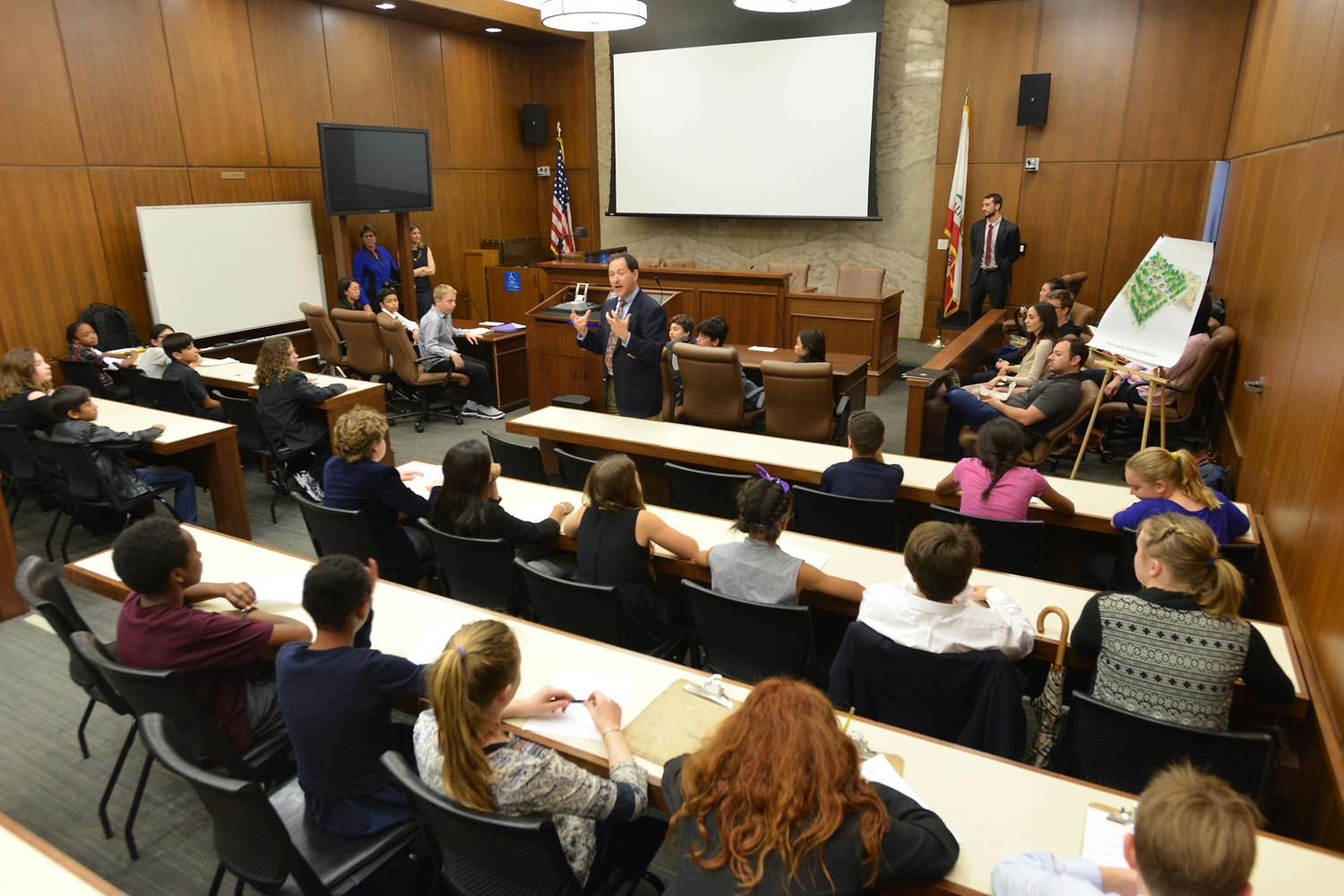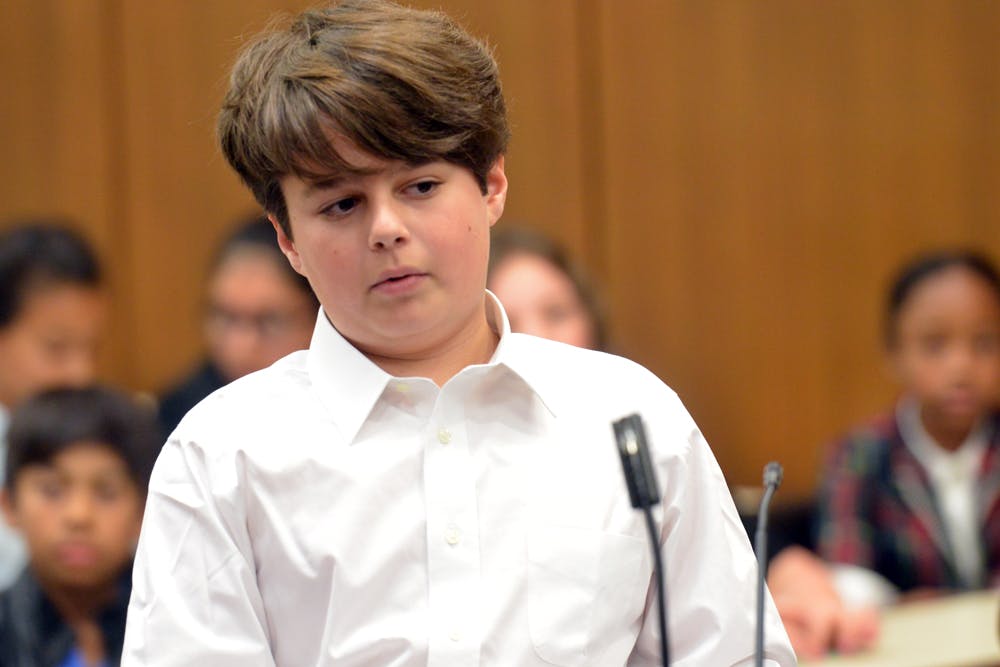It was like any ordinary mock trial in the Cappello Courtroom at UCLA’s School of Law. Except that the plaintiff and defendant lived more than 1,000 years apart, a one-eyed goatherd served as a character witness, and members of each side’s legal team had to use a stepstool to address Judge Lara Stemple, director of Graduate Studies and the Health and Human Rights Law Project at UCLA Law.

Last month, 43 upper grade students from UCLA Lab School took part in a mock trial for a defamation case involving the plaintiff Hammurabi, King of Babylonia and Mesopotamia (1792 – 1750 BC) vs. the defendant Nebuchadnezzar II, King of Babylonia and Mesopotamia (605 – 562 BC). Hammurabi was being sued by Nebuchadnezzar for making a public statement in which he claimed to be a superior king. While not present at Hammurabi’s declaration, Nebuchadnezzar filed a defamation lawsuit against him on the grounds that he was distraught by his rival’s remarks.

After a week of instruction and preparation by Jill Horwitz, UCLA Law Professor and Associate Director of the Center for Law and Economics at UCLA, and students from the UCLA Education & Law Society, the sixth graders acted as attorneys and witnesses on behalf of their respective “clients.”
Xander Hadley took the stand as the one-eyed goatherd, testified against King Hammurabi’s leadership abilities. He said that the famed Hammurabi’s Code of Law that required him to forfeit an eye in exchange for a neighbor’s loss of an eye was “stupid and unfair.”

Susan DeBlasio, who teaches history and literacy to sixth graders at UCLA Lab School, says that the mock trial was “an experience that the Upper II students from the Lab School will never forget.”
“The UCLA Law students’ passion, commitment and the positive process of preparing our students for the trial was extraordinary,” she says. “[Our students] learned so much about the judicial process and rules of the court and the significance of the roles of the prosecution and the defense. Acting out the trial between Hammurabi and Nebuchadnezzar in the Law School Courtroom brought the whole experience to life.”

As the case unfolded, the high level of research and attention to detail that the UCLA Lab School students were striving to achieve was evident. Each legal “team” argued for the defendant or plaintiff convincingly, while observing the requirements for a defamation case. Witnesses presented the pros and cons of each side of the case – Hammurabi was a strong ruler concerned with social equity and the greater good; Nebuchadnezzar built wonderful monuments such as the Hanging Gardens of Babylon, but at a price. Ultimately, the jury – which was made up of UCLA Law students – was not convinced beyond a reasonable doubt of the damages suffered by Nebuchadnezzar, and found King Hammurabi not guilty of defamation of character.
Professor Horwitz – whose son with Edward “Ted” Parson, the Dan and Rae Emmett Professor of Environmental Law at UCLA, and Faculty Co-Director of the Emmett Institute on Climate Change and the Environment at UCLA, is a Lab School student – says that it was exciting to see the middle grade students interact with students from UCLA Law.

“When I watched the trial, it was obvious to me how much the sixth graders truly understood the issues,” Horwitz says. “With the support of the law school students – many of whom had been teachers before coming to law school – the [Lab School students] were able to make arguments for their side of the case but also analyze the strengths and weaknesses of their case. We can’t wait to do this again.”

Students from the Education Law Society commended the UCLA Lab School students for their efforts and professionalism during the mock trial, particularly those students who served as witnesses on the stand. Previous witnesses were played by UCLA Law students. Brett Manisco, co-chair of the Education & Law Society, commended the diligence and discovery of the UCLA Lab School students as they prepared for the mock trial.
“Working on the Mock trial with the lab school students was an absolute pleasure,” he says. “With each day of trial prep, the law students saw incremental growth in the [UCLA Lab School] students’ understanding of how to structure complex legal arguments. It seemed as though there were constantly little light bulbs going off over their heads as they developed a thorough understanding of the case and formulated new creative approaches to the issues. For me, seeing [the sixth graders’] hard work each day translate into growth, their ability to understand their roles, and make legal arguments was the most rewarding aspect of the whole experience.”

Once the verdict was announced, the aspiring attorneys and witnesses on the winning side celebrated with hi-fives and cheers. But everyone in the courtroom was rewarded with cookies.
This is the third year that UCLA Law has provided the mock trial experience for UCLA Lab School. The materials used for putting on this year’s mock trial – which also tried the case of Hammurabi vs. Nebuchadnezzar – were initially developed by UCLA Law students on last year’s Education & Law Society board. Two years ago, the case of State of Bruin v. Gold E. Locks was tried by third and fourth graders from UCLA Lab School. The case, in which Gold E. Locks was accused of breaking and entering and theft of porridge, resulted in a split verdict.
Above: Sixth graders from UCLA Community School – some of whom used a stepstool to address UCLA Law Professor Lara Stemple, who served as judge – worked with UCLA Law students to present a mock trial.
All photos by Todd Cheney, UCLA
